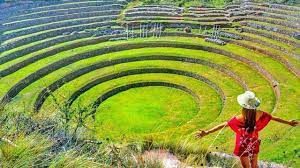Nestled amidst the breathtaking landscapes of Peru, just a stone’s throw away from the historic city of Cusco, lies an archaeological wonder that continues to intrigue and captivate visitors from around the world: Moray. This enigmatic site, tucked away in the Andean highlands, stands as a testament to the ingenuity and advanced agricultural practices of the ancient Inca civilization.
A Glimpse into the Past
Moray comprises a series of concentric terraces carved into a natural depression in the earth, forming what appears to be an otherworldly amphitheater. While the exact purpose of these terraces remains a subject of debate among historians and archaeologists, many believe that they served as an agricultural laboratory for the Incas.
Constructed during the height of the Inca Empire, which thrived between the 15th and 16th centuries, Moray is thought to have been utilized for experimentation with different crop varieties and growing conditions. The varying microclimates created by the terraces allowed the Incas to cultivate a wide range of crops, adapting to the diverse environmental conditions present throughout the empire.
Engineering Marvels
What makes Moray truly remarkable is the precision and sophistication of its engineering. The terraces are meticulously constructed, with each level carefully designed to capture and retain heat from the sun. As a result, the temperature difference between the top and bottom levels of the terraces can vary by as much as 15 degrees Celsius (27 degrees Fahrenheit), creating a microclimate conducive to agriculture.
Furthermore, the layout of Moray reflects an advanced understanding of hydrology and irrigation systems. Channels and drainage systems built into the terraces efficiently manage water flow, preventing erosion and ensuring optimal moisture levels for crop growth. This mastery of water management was crucial for sustaining the expansive agricultural networks that supported the Inca Empire’s population.
Cultural Significance
Beyond its practical functions, Moray likely held significant cultural and ceremonial importance for the Incas. Some scholars suggest that the site may have been used for religious rituals or as a center for agricultural ceremonies, where offerings were made to honor Pachamama, the Inca goddess of fertility and agriculture.
Visitors to Moray can’t help but be awestruck by the site’s beauty and grandeur. Surrounded by the towering peaks of the Andes and set against the backdrop of vast, open skies, the terraces of Moray evoke a sense of wonder and reverence for the ingenuity of ancient civilizations.
Preservation and Tourism
Today, Moray is a protected archaeological site under the care of the Peruvian government. Efforts to preserve and maintain the ruins ensure that future generations can continue to marvel at this remarkable testament to Inca engineering and agricultural expertise.
Despite its remote location, Moray has become increasingly popular among tourists visiting the Cusco region. Guided tours offer visitors the opportunity to explore the site and learn about its history and significance from knowledgeable guides. Additionally, nearby attractions such as the Maras salt mines and the picturesque village of Ollantaytambo make Moray a must-visit destination for anyone interested in exploring Peru’s rich cultural heritage.
Conclusion
Moray stands as a testament to the remarkable achievements of the Inca civilization and serves as a reminder of the enduring legacy of ancient cultures. Its intricate terraces and advanced engineering continue to inspire awe and curiosity, inviting visitors to delve deeper into the mysteries of Peru’s past. As one of the most fascinating archaeological sites near Cusco, Moray offers a glimpse into a bygone era and a profound appreciation for the ingenuity of the Incas.



